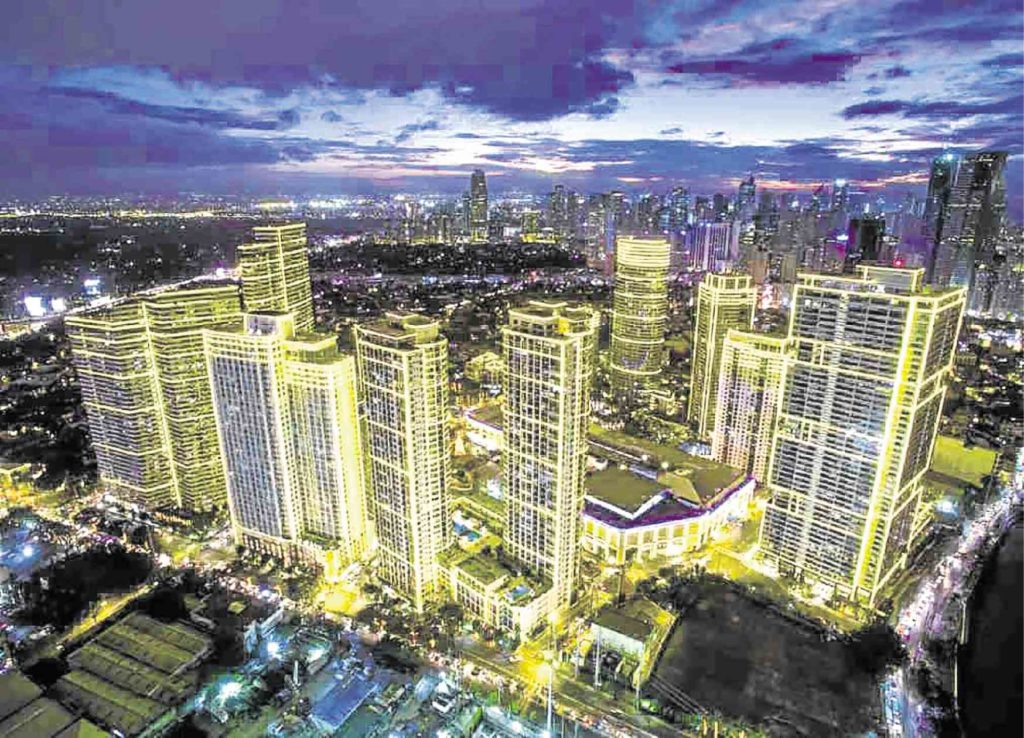How developers bridge gaps

A thermal power plant used to occupy a portion of Rockwell Center in Makati before it was transformed into a self-sufficient, self-contained community.
The Philippine real estate industry is playing an even bigger role other than just providing homes.
On a larger scale, property developers are in fact also “bridging infrastructure gaps and unlocking opportunities by building masterplanned communities that have the potential to become major catchment areas for business activities in the country’s capital,” according to the latest white paper by Colliers International Philippines.
“The government’s failure to adequately address issues plaguing Metro Manila such as worsening traffic, flooding, and poor mass transportation systems has compelled private firms to take the lead in developing master-planned communities that integrate the live-work-play lifestyle. The expansion of economic activities in the country’s capital has also buoyed demand for integrated communities,” explained Joey Roi Bondoc, manager for research at Colliers.
In the white paper entitled “Shifting Orbits: The Rise of Satellite Communities”, Bondoc noted that the rising demand for these integrated developments as well as soaring land values in established business hubs have provided the opportunity for developers to transform idle properties into masterplanned communities.
For example, Eastwood City was the former site of a textile mills; a thermal power plant used to occupy a portion of Rockwell Center in Makati; Century City was the former site of International School Manila; while Capitol Commons was a redevelopment of the former capitol of Rizal Province.
Article continues after this advertisementValue proposition
Article continues after this advertisementColliers, according to Bondoc, expects developers to continue pursuing masterplanned communities as these offer a better value proposition than standalone projects.
“We believe that the emergence of millennial workers, who account for about 40 percent of the country’s labor force and are primarily employed in business process outsourcing firms, will sustain the demand for integrated live-work-play environment,” Bondoc said.
Bondoc further noted that the concept of building offices, condominiums, malls, schools and hospitals within one community satisfies the millennials’ demand for greater mobility and convenience.
Evidently, the increasing demand for such communities and the rising values of land that have been developed as such have enticed even the industrial property owners in strategic locations to liquidate land holdings in favor of mixed-use township developments. Examples of these are the upcoming projects along C-5 Road namely Megaworld’s ArcoVia City and Robinsons Land’s Bridgetowne.
Add to that the national and local governments’ thrust of raising non-tax revenues, which has compelled a number of agencies to put large land parcels out to tender to major property developers.
These parcels are now being transformed into satellite communities that offer specific value propositions, examples of which include the Vertis North, which is being positioned as the new central business district of Northern Metro Manila; Makati Circuit which is being groomed as the next entertainment hub; and Arca South which is poised to serve as the Southern gateway to the country’s capital.
Out of the metro
Developers have also been aggressive in building townships outside of Metro Manila.
“Colliers sees developers pursuing more integrated communities outside of Metro Manila such as Cavite, Laguna, Bulacan, and Pampanga over the near- to medium-term as land values are unlocked by an aggressive expansion of road networks. We are confident that this will be sustained by the government’s push to generate economic opportunities in the countryside anchored on its commitment to usher in the golden age of infrastructure,” Bondoc explained.
These infrastructure projects include the recently-completed Muntinlupa-Cavite Expressway (MCX) as well as Light Rail Transit (LRT) 1 Cavite extension; the Cavite-Laguna Expressway (CALAx); and North Luzon Expressway (NLEX) and South Luzon Expressway (SLEX) connector road which are under construction.
“With several infrastructure and township investments in the pipeline, we expect Cavite to come to its own as an urban center and rise from its previous image as a mere suburban support area to Metro Manila. To the north, we see Pampanga cornering the bulk of township-related investments in the region given the government’s commitment to develop the North Luzon segment of North-South Railway project and expand the existing Clark International Airport,” Colliers noted.
Differentiation
There is a need, however, for real estate developers to distinguish their projects from others, amid an increasingly competitive environment for township development. Apart from the typical land uses such as office, residential, retail, and hotel, developers should also incorporate institutional uses such as education and healthcare.
Other developers have been more aggressive in “differentiating” their communities by integrating entertainment and recreational facilities for outdoor sports such as football and wakeboarding.
To cash in on the growing demand for master-planned communities, developers also need to intensify efforts in terms of strategic landbanking, according to Colliers.
“Within Metro Manila, opportunities for township developments are in Quezon City North (Fairview, San Jose del Monte, Novaliches and Commonwealth), Marikina and Pasig. Meanwhile, other provinces that are viable locations for township include La Union, Pangasinan, Tarlac, Batangas, Naga, Iloilo, Bacolod, Cebu, Davao, and Cagayan de Oro,” Colliers said.
“Developers should also be on the lookout for ongoing reclamation projects in the Manila Bay Area as a potential supply of developable land; aggressively scout for idle private properties or government assets that they can acquire and redevelop into master-planned communities; and develop flexible office space to accommodate firms that require smaller space,” the firm further stated.